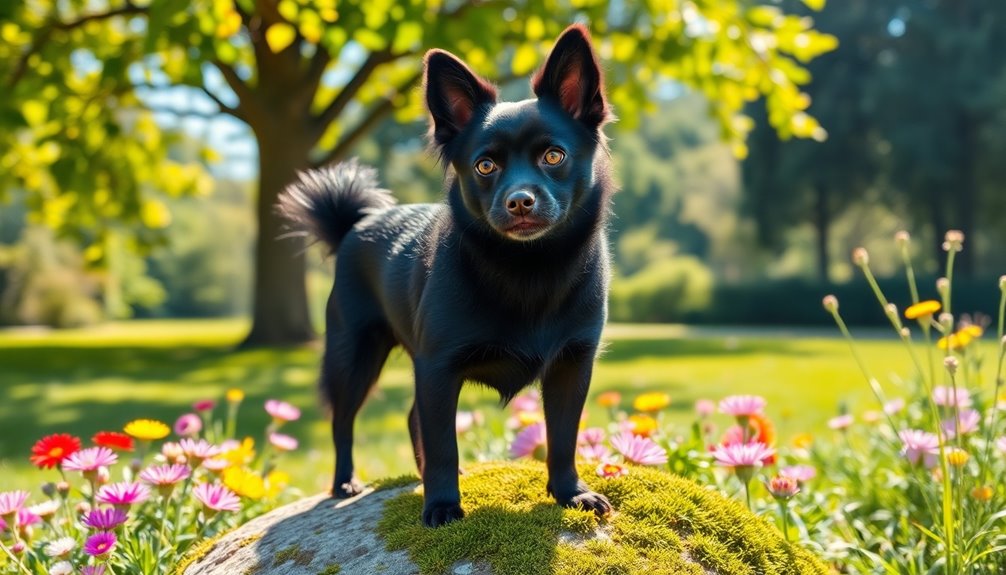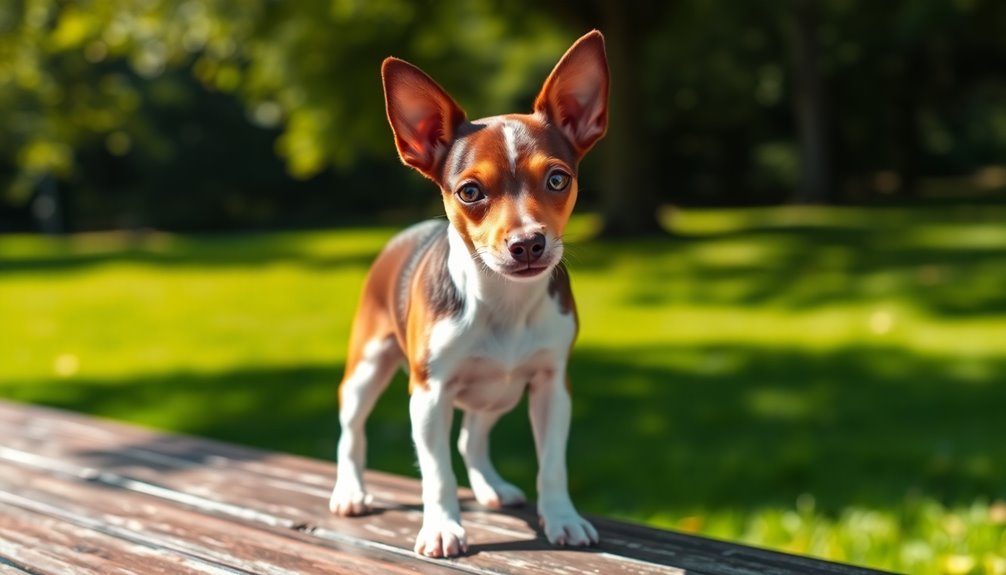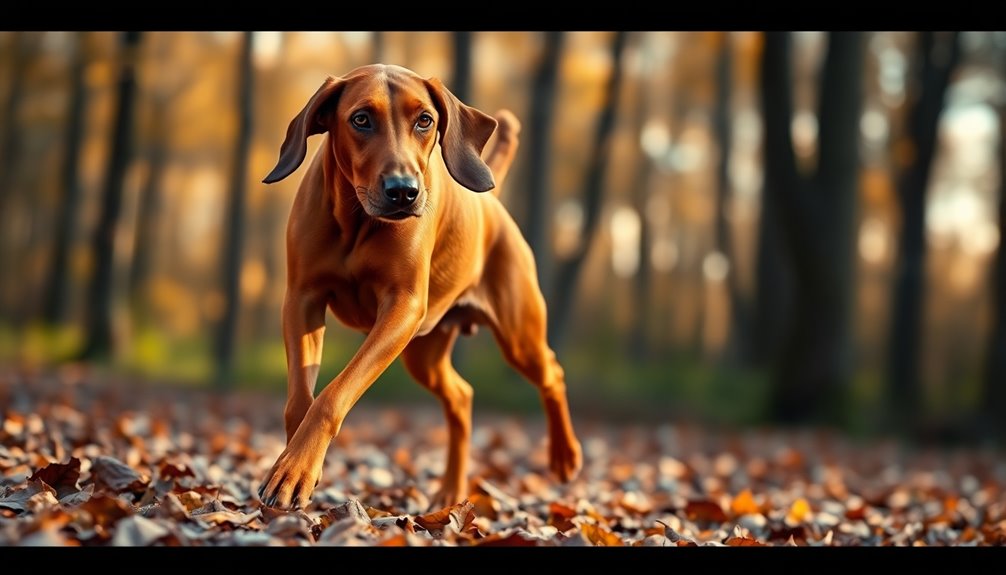The Schipperke, known as the "little captain," is a lively and inquisitive dog that brings joy and energy to any household. Standing around 10 to 13 inches tall, these robust, double-coated pups are primarily black but can also be blonde or cream. They've got a playful spirit and require about 40 minutes of exercise daily to keep them happy. Their independent nature means they thrive with structure and stimulation, while early socialization is key to managing their curiosity. If you're curious about their history or care needs, you'll find even more fascinating details ahead.
Key Takeaways
- Schipperkes are small, energetic dogs known for their playful and inquisitive nature, making them ideal companions for families.
- With a robust build, they typically stand 10 to 13 inches tall and weigh between 6.6 to 19.8 pounds.
- Originating from Belgium in the 1600s, they were initially bred for guarding and pest control on boats and farms.
- Their distinctive double coat requires moderate grooming, with increased shedding during seasonal changes.
- Schipperkes thrive on 40 minutes of daily exercise and benefit from socialization and training to harness their independent spirit.
Introduction

When it comes to small yet spirited breeds, the Schipperke stands out as a curious and energetic companion. You'll quickly notice their distinctive features, including a long ruff around the neck and culottes on their hind legs, giving them a unique, charming appearance.
Males typically reach about 33.6 cm (13.2 in) in height, while females are slightly smaller at 31.2 cm (12.3 in). Weighing between 3 to 9 kg (6.6 to 19.8 lb), these little dogs are robust and full of life, often sporting a shiny black coat, though you might also find them in blonde or cream shades. They are a double-coated breed, which contributes to their unique appearance and resilience in various weather conditions.
Schipperkes are known for their high energy levels, requiring about 40 minutes of exercise daily to keep them happy and healthy. They thrive on social interaction and prefer being near their owners.
While they're highly intelligent, be prepared for a bit of stubbornness, which can make training a challenge. They also have a strong prey drive, so keep an eye on them around small animals.
With proper care, including moderate grooming and socialization, you'll enjoy a loyal and spirited friend for many years.
History and Origin
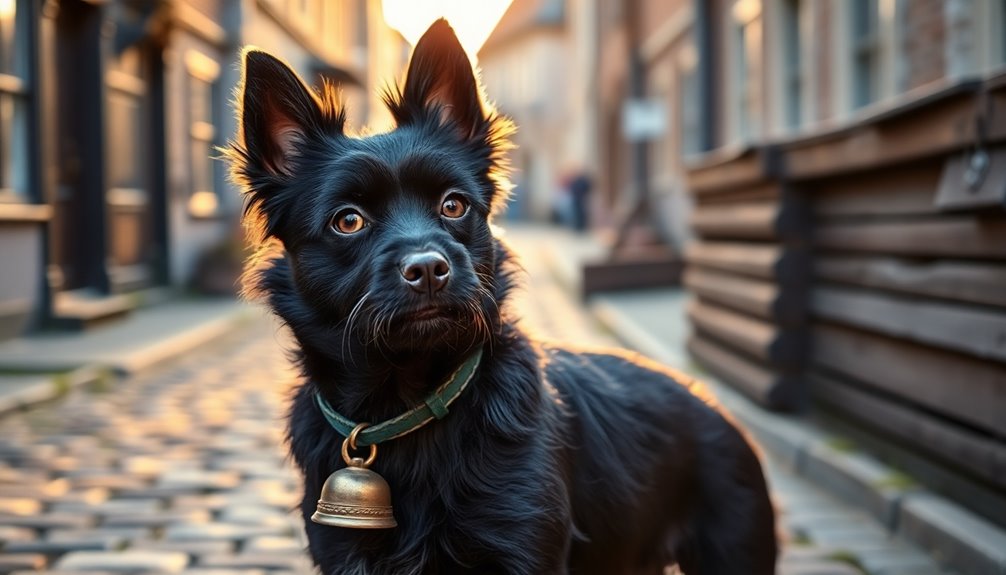
The Schipperke breed traces its roots back to the 1600s in Flanders, where it was likely developed from the Leuvenaar, a larger shepherd dog. Originally bred for guarding flocks and controlling rat populations, these energetic little dogs quickly became essential watchdogs on farms and boats. Their cleverness and loyalty made them invaluable companions in both rural and urban settings. Founders of the Colonial Schipperke Club played a vital role in promoting the breed and ensuring its legacy through dedicated breeding practices.
Where and when the breed originated
In the 1600s, the Schipperke breed emerged in Belgium, evolving from a black sheepdog known as the Leauvenaar. This lively little dog found its roots in the Flemish provinces, where it was initially called Spitzke or Spits. Early documentation notes a show for Schipperkes held in the Grand Palace of Brussels in 1690, marking the breed's initial recognition.
The name "Schipperke," meaning "little captain" in Flemish, reflects its maritime heritage, as it was often associated with barge dogs. Many people mistakenly link the breed with Dutch origins due to the historical connections between Belgium and Holland. However, Schipperkes were especially popular among shoemakers and tradesmen in Brussels and Antwerp, where they became well-loved companions.
Royal recognition arrived in 1885 when Queen Marie-Henriette of Belgium discovered the breed. The Schipperke made its first dog show appearance in 1880, quickly winning the hearts of many. Known for their energetic demeanor, Schipperkes thrive in active households and are eager to participate in various activities with their families.
Rat Control and Watchdog Duties
Efficiency in pest control and vigilance defines the Schipperke's historical roles. Originally bred to hunt down rats and other vermin, these spirited little dogs served as ratters on canal barges, which was crucial for their survival and that of the cargo.
With their high prey drive, agility, and speed, Schipperkes excelled in exterminating rodents, ensuring a clean and safe environment for their human companions. Their ancestry as herding dogs contributed to their exceptional abilities in managing and controlling pest populations.
Beyond their rat-catching duties, they earned the nickname "Little Captain" by serving as loyal companions to barge captains. Shopkeepers also relied on them for pest control while they stood guard over their shops.
Exhibited in one of the first specialty dog shows in 1690, Schipperkes showcased their skills as faithful night watchmen.
Schipperkes are known for their excellent watchdog characteristics. They're light sleepers, curious, and alert, capable of barking to notify you of anything unusual.
Their loyalty and devotion to families are remarkable, although they can be independent. With high energy levels and a strong instinct to chase, they require daily exercise and consistent training to thrive as both effective pest controllers and vigilant watchdogs.
Physical Characteristics
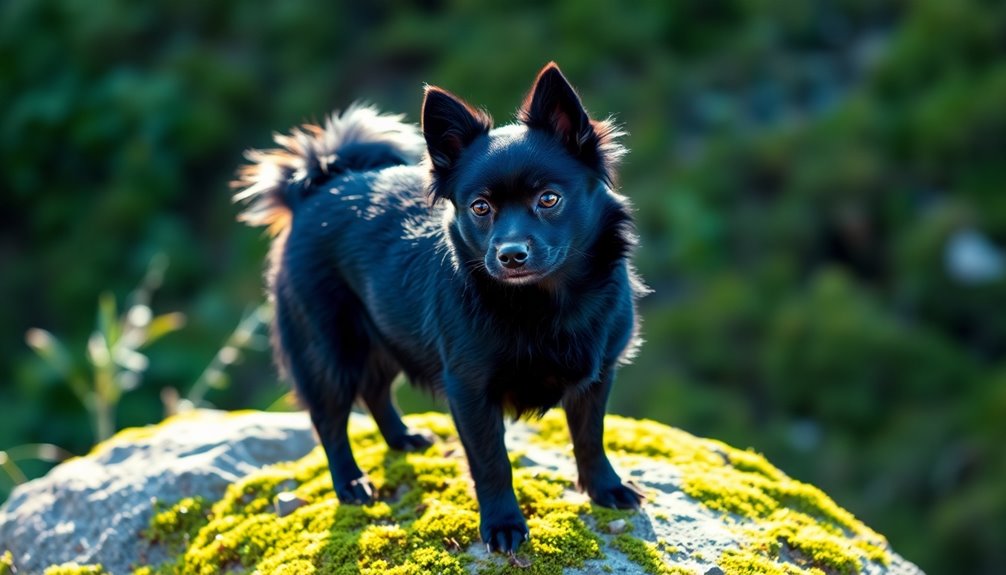
When you look at a Schipperke, you'll notice their compact size and sturdy build, standing between 10 to 13 inches tall. Their striking double coat features a soft undercoat and a harsher outer layer, giving them a distinctive look, which can vary in color due to the influence of genetic loci. Don't forget to check out their unique tails, which curl over their backs, adding to their charming appearance.
Size, weight, and coat details
The Schipperke, a compact and energetic breed, stands between 10 to 13 inches tall, with females typically measuring 10 to 12 inches and males ranging from 11 to 13 inches. These little captains are square in profile and sport a solidly built body that exudes strength despite their small stature.
When it comes to weight, Schipperkes range from 6.6 to 19.8 pounds, making them light yet sturdy companions. At just 2 months old, they weigh between 3.8 to 5.7 pounds and can gain an additional 3.69 pounds by 4 months. Males and females generally reach similar final weights, ensuring that owners can expect consistent size in their Schipperkes.
Their coat is double-layered, featuring a firm, harsh outer coat and a soft, thick undercoat. The body coat is moderate and close-lying, while longer hair around the neck forms a striking ruff, cape, and jabot. You'll find shorter hair on their legs, with longer hair on the back of their thighs.
Schipperkes typically come in solid black, blonde, or brown, and require moderate grooming. Regular brushing helps manage their low shedding, which increases during the seasonal coat "blow."
Tail Curled Over Back
Schipperkes are known for their distinctive tails, which often curl over their backs, adding to their unique charm. These naturally tailed dogs can have tails that vary in length and carriage, from broad at the base to tapering at the end. Some Schipperkes sport straight tails, while others proudly display a curled tail, creating an eye-catching silhouette.
Historically, many Schipperkes had docked tails, leading to the misconception that they're naturally tailless. When docking is practiced, it's typically to no more than one inch. However, this practice is declining in some countries due to changing regulations.
Today, you may encounter Schipperkes with full tails, bob tails, or even those born entirely tailless, showcasing the breed's genetic diversity. The T-Box mutation plays a significant role in the tail characteristics of Schipperkes. If you breed a bob tail, there's a 50% chance the offspring will also have a bob tail, but breeding two bob tails can lead to complications.
Additionally, the breed's history as boat dogs contributed to their tail characteristics, as they were originally used for guarding barges. Regardless of tail type, all Schipperkes should be judged according to the breed standard, ensuring that each unique characteristic is appreciated equally.
Temperament and Personality
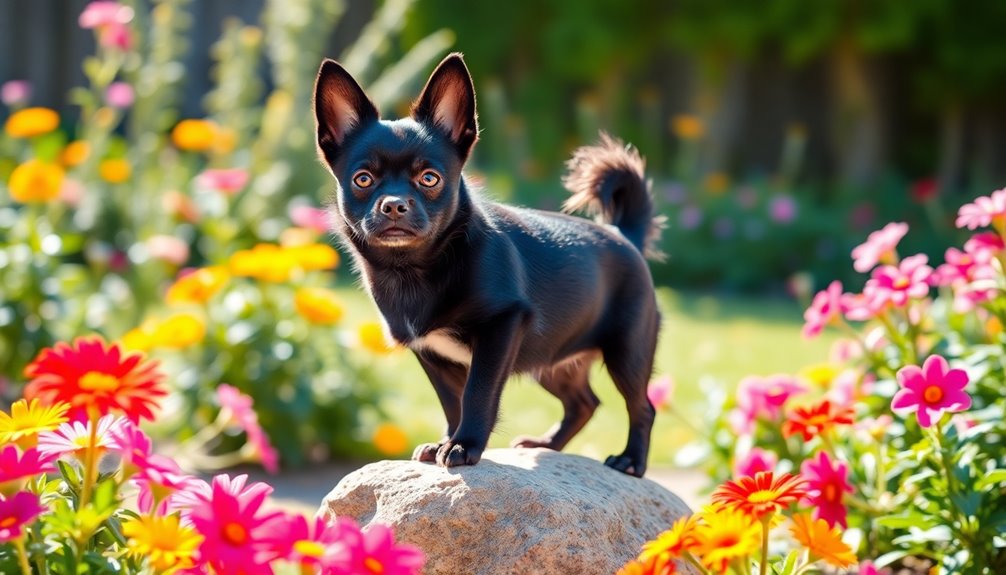
When you consider a Schipperke, you're looking at a playful and inquisitive companion that thrives in family settings. Their energetic nature makes them great for active individuals or homes with children, as long as they receive proper socialization. Just remember, their independent streak means they also need structure and stimulation to keep them happy and well-behaved. They typically require 40 minutes of activity daily to maintain their energy levels.
Playful and Inquisitive Nature
With a playful spirit and an inquisitive mind, Schipperkes bring a vibrant energy to any home. These energetic dogs thrive on activity, needing regular exercise and mental stimulation to keep them happy. If they don't get enough engagement, you might find them barking excessively, chewing on furniture, or digging up your yard.
Their curiosity knows no bounds, making them adventurous little explorers. You'll often catch them investigating every nook and cranny of their surroundings, which can lead to delightful mischief. While their intelligence fuels their explorative behavior, it's crucial to socialize them early to manage their tendency to wander off. Schipperkes can be born with different tail variations that add to their unique charm and personality.
Despite their small size, Schipperkes exude confidence and fearlessness, earning them the nickname "little black devils." They'll faithfully guard your home, alerting you to anything amiss. However, their stubborn streak can make training a challenge. Be prepared to commit to consistent training and early socialization to ensure they develop good behaviors.
Incorporating puzzle games and interactive play into their routine will keep their minds sharp and their spirits high, making them the perfect companions for an active lifestyle.
Suitability for families, individuals, or other pets
For families, individuals, and those with other pets, the Schipperke's temperament and personality can be a perfect match, provided the right environment is created. These small dogs are loyal and loving, making them great family pets. However, you'll need to supervise interactions with young children to prevent injuries and ensure proper socialization. They thrive on interaction and can suffer from separation anxiety if left alone for too long. Their high energy levels mean they require regular mental and physical stimulation to stay happy and healthy.
As for individuals, Schipperkes make excellent companions for those who can give them constant affection. They need regular exercise but don't require extensive workouts, so daily walks and playtime can easily fit into your routine. Just remember, they can be stubborn, so patience and experience in training are essential.
When it comes to other pets, early socialization is crucial. Schipperkes may show aggression toward other dogs if not properly introduced. While they can coexist with cats and well-behaved larger dogs, caution is advised. Their strong prey drive means keeping them away from small animals is necessary. With the right approach, a Schipperke can become a delightful addition to your family or household.
Health and Lifespan

When it comes to your Schipperke's health and lifespan, knowing what to expect can help you provide the best care.
With a median lifespan of around 13 years, this breed typically enjoys a good level of health, but they're not immune to certain genetic issues. Adhering to APA style guidelines can also enhance your understanding of health-related research pertaining to this breed.
Typical lifespan of the breed
The typical lifespan of a Schipperke ranges from 12 to 14 years, though many can live up to 15 years or more with proper care. According to a UK Kennel Club survey, the median lifespan is about 13 years. You might even hear of some Schipperkes living up to 17.5 years, showcasing the potential longevity of this energetic breed.
To help your Schipperke reach their full lifespan, you need to focus on several key factors. Proper care, including balanced nutrition and regular veterinary visits, is crucial. Inactivity, lack of exercise, and overfeeding can harm their health, so make sure to provide them with plenty of playtime and physical activity. Schipperkes are known for their powerful watchdog abilities, making them not only great companions but also vigilant protectors of their home.
Regular health checkups are essential as well; puppies under six months should see the vet monthly, while adults should have annual visits. For seniors over ten years, semi-annual checkups help monitor their health closely.
Early detection of any health issues can significantly improve their prognosis, allowing you to enjoy many happy years with your furry companion. By staying proactive in their care, you can help your Schipperke thrive well into their golden years.
Common health concerns or genetic predispositions
Schipperkes can face several common health concerns and genetic predispositions that potential owners should be aware of. One significant genetic disorder is Mucopolysaccharidosis (MPS) IIIB, which may manifest as late-onset tremors, ataxia, and behavioral changes, typically appearing between 2 and 4 years old. Unfortunately, this condition often leads to euthanasia before they reach six years of age. This disorder is caused by mutations in the NAGLU gene and primarily affects Schipperke dogs.
Another inherited issue is Progressive Retinal Atrophy (PRA), which causes blindness, starting with symptoms like night blindness around 3-5 years.
You might also encounter conditions like Color Dilution Alopecia, affecting blue-coated Schipperkes, or Cryptorchidism, where one or both testes remain undescended.
Hypothyroidism is common in this breed, impacting overall metabolism. Moreover, Schipperkes can be predisposed to certain cancers, such as Muco Epidermoid Carcinoma, and both genetic and environmental factors may contribute to these risks.
Allergies and eye problems are additional concerns, so early intervention is crucial. Being aware of these health issues can help you monitor your Schipperke and ensure a happier, healthier life.
Tips for maintaining health and wellness
Maintaining your Schipperke's health and wellness is essential for ensuring a long, vibrant life. Start with nutrition: choose high-quality dog food rich in animal protein, and avoid table scraps to prevent obesity. Incorporate healthy treats like fruits and veggies in moderation, and always provide fresh, clean water. During warmer months, consider foods with moisture to help keep them hydrated.
Grooming is also vital. Bathe your Schipperke every four to six weeks with gentle shampoo, trim their nails regularly, and clean their ears to prevent infections. Brush their coat at least weekly to avoid mats, especially since they shed more heavily in spring and fall. Regular grooming is crucial for maintaining coat health, which contributes to overall well-being.
Training and socialization can't be overlooked. Begin training early, using patience and consistency, and balance playtime with relaxation to support their mental health. A safe, loving environment with a predictable routine will enhance their emotional well-being.
Lastly, ensure regular veterinary check-ups, maintain a daily exercise routine, and provide regular breaks and rest. With proper care, your Schipperke can live up to 16 years, bringing joy and companionship to your life.
Care Requirements
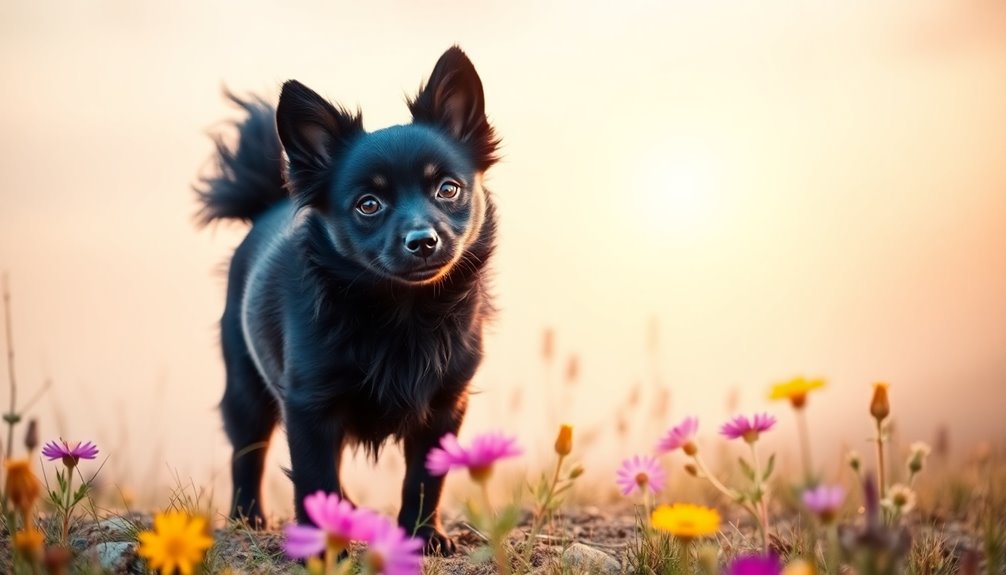
Taking care of your Schipperke involves understanding their unique grooming, exercise, and dietary needs. You'll find they've minimal shedding, making grooming easier, but they still require regular brushing and exercise to stay healthy and happy. Feeding them a balanced diet and keeping up with their energy levels are key to ensuring your little captain thrives. Additionally, providing regular exercise is necessary for their physical fitness and overall well-being.
Minimal Shedding, Easy Grooming
When it comes to grooming, the Schipperke's coat requires some attention but isn't overly demanding. This breed has a striking, black, medium-length double coat, which is thick and fluffy. You'll find the longest fur on their neck, chest, and limbs. While they shed twice a year, in spring and fall, regular grooming can make this manageable. Typically, weekly brushing is enough to keep your Schipperke's coat healthy and shiny. However, during shedding seasons, you'll want to brush daily to remove loose undercoats. Using a bristle or slicker brush will help you maintain the coat's dense texture effectively.
A monthly bath is recommended, or more frequently if your pup gets dirty. Remember to thoroughly shampoo to clean down to the skin, followed by a light conditioner to nourish the fur. Additionally, maintaining a healthy diet is essential for keeping their coat in top condition.
In addition to coat care, don't forget about other grooming needs. Regularly trim their nails to maintain foot shape, clean their ears, and brush their teeth. Checking for any skin issues and monitoring their eyes for discharge is also essential.
With this routine, your Schipperke will look and feel great!
Exercise requirements and energy levels
Schipperkes typically need about 30 minutes of exercise each day to keep their energy levels in check. Daily walks, jogs, and play sessions in a fenced-in yard are perfect for them. Despite their small size, these dogs can walk up to 10 miles and run up to 5 miles without tiring. However, always keep them on a leash due to their potential aggression, especially around strangers.
To keep your Schipperke mentally and physically stimulated, mix up their activities. They thrive on challenges and excel in dog sports like agility and rally. They're highly active indoors too, making them suitable for apartment living, as long as they get their daily walks and playtime. Additionally, their high intelligence makes them well-suited for learning new tricks and commands, which can further engage their minds.
With their moderate to high energy levels, it's essential to prevent boredom; otherwise, they might resort to destructive behaviors. Socialization is crucial, as it limits excessive barking and aggressive tendencies.
Regular exercise not only helps maintain their health but also prevents common issues like patellar luxation and hypothyroidism. Keep an eye on their health and schedule annual vet check-ups to catch any potential problems early.
Feeding tips and diet recommendations
To keep your Schipperke healthy and happy, focus on providing a balanced diet tailored to their specific needs. High-quality dog food should meet nutritional requirements based on age, size, and activity level.
Prioritize animal-based proteins like beef, chicken, and fish, while including essential fatty acids and omega-3s for skin, coat, and joint health. Small amounts of carbohydrates from veggies and berries are acceptable, but fresh water must always be available. A natural, whole food diet can greatly enhance your Schipperke's overall health and happiness.
For feeding frequency, adults should get measured amounts twice a day, while puppies need at least three meals to prevent low blood sugar. Avoid free-feeding; measure portions carefully to prevent obesity. Snuffle mats or slow feeder bowls can enhance mental stimulation during mealtimes.
Consider raw or fresh whole-food diets made from human-grade ingredients to support your Schipperke's health. Steer clear of highly processed kibble, which can lead to health issues.
If necessary, add omega-3 supplements for additional support. Always consult your veterinarian for specific dietary recommendations, especially if your dog faces common health issues.
Avoid table scraps to help maintain a healthy weight and prevent obesity-related problems.
Training and Socialization
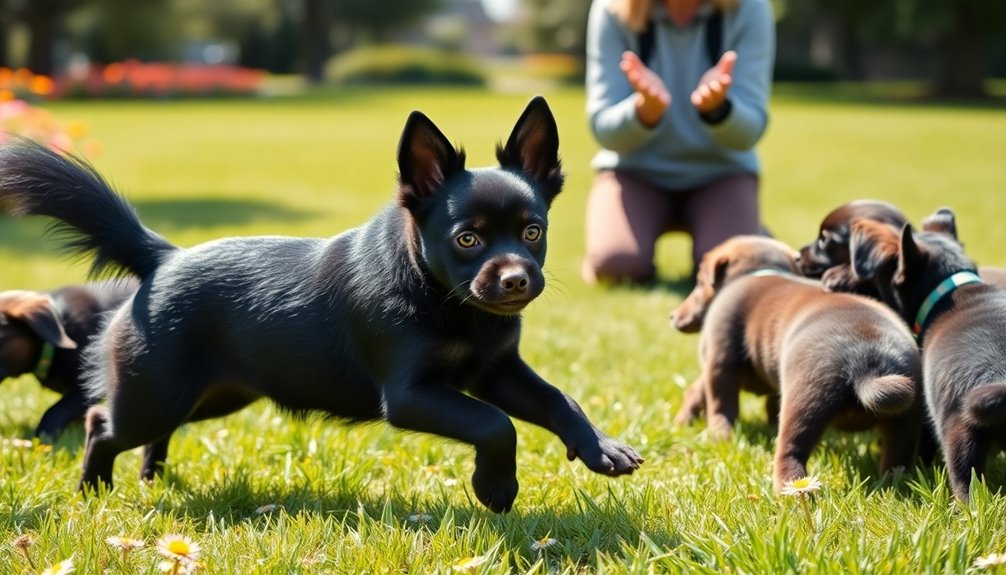
Training and socializing your Schipperke requires patience and a thoughtful approach. Since they're moderately independent, you'll need to use gradual introductions to new environments to help them feel comfortable. Keep in mind that they may show leash reactivity with strangers, so consistent training is key to managing their behavior. Incorporating positive reinforcement techniques can enhance their learning and strengthen your bond during training sessions.
Moderately Independent, Requires Patience
When welcoming a Schipperke into your home, it's important to recognize their moderately independent nature, which can make training a unique challenge.
These clever little dogs are highly intelligent and can learn various commands and tricks. However, their stubborn streak means they might test your boundaries. To effectively train your Schipperke, you'll need patience, consistency, and clear boundaries. Utilizing mindfulness techniques during training can help you stay calm and focused, improving the overall experience for both you and your dog.
Using positive reinforcement techniques like treats and praise can motivate them while maintaining their interest. To prevent boredom, keep training sessions varied and engaging. Establishing a routine also helps Schipperkes thrive, as they respond best to structure. Additionally, providing them with mental stimulation through interactive toys can further enhance their training experience.
Be prepared for some cunning behavior; they might find creative ways to open cupboards or escape the yard. Therefore, managing their independent spirit requires a combination of firm yet gentle correction alongside positive reinforcement. This approach will help you navigate their obstinacy while fostering a strong bond.
Remember that early socialization is essential, as it allows your Schipperke to adapt well to different environments and people.
With patience and dedication, you'll guide your Schipperke to be a well-behaved and happy companion.
Gradual Introductions to New Environments
Gradual introductions to new environments are crucial for helping your Schipperke adjust and thrive. Start socializing your puppy by or before three weeks of age, continuing through at least 20 weeks. During this period, your Schipperke will be most receptive to learning from exposure to unfamiliar people and other dogs. Positive experiences in diverse environments will help reduce anxiety and foster confidence.
Introduce your puppy to various sights, sounds, and smells, from different types of flooring to an array of toys. Don't forget to expose them to different people—young, old, and those with unique appearances—to create a well-rounded social experience. Involve family members early on and gradually introduce strangers one at a time to avoid overwhelming your puppy. Early handling by breeders promotes friendly, confident dogs, which lays a solid foundation for successful socialization.
Use positive reinforcement techniques, like treats and praise, to ensure that every interaction is enjoyable. Make socialization fun by incorporating playtime activities such as fetch.
Remember to take baby steps; assess your puppy's responses and adapt your approach as needed. By doing this, you'll help your Schipperke become a confident, well-adjusted companion ready to explore the world alongside you.
Leash Reactivity With Strangers
Leash reactivity with strangers is a common challenge for many Schipperkes, often stemming from fear or frustration. When your dog feels confined by the leash, they might react defensively, especially if they've had negative experiences in the past. Inadequate socialization during formative months can lead to apprehension and reactivity, making it essential to establish clear rules and expectations.
To combat this, start by socializing your Schipperke early on. Introduce them to various people and environments to build their confidence. Use positive reinforcement techniques, rewarding calm behavior with treats or praise when they encounter strangers. This builds trust and enhances their ability to cope with high canine presence in various settings.
Counterconditioning can help, gradually exposing your dog to triggers at a safe distance while rewarding them for remaining calm. Training methods like "heel" can redirect your dog's focus back to you, encouraging them to walk calmly beside you. Incorporating "look at that" cues can also redirect their attention away from potential triggers.
Remember to keep training sessions short and fun, especially for younger dogs. With patience and practice, your Schipperke can learn to navigate the world with less reactivity, making walks enjoyable for both of you.
Ideal Living Environment
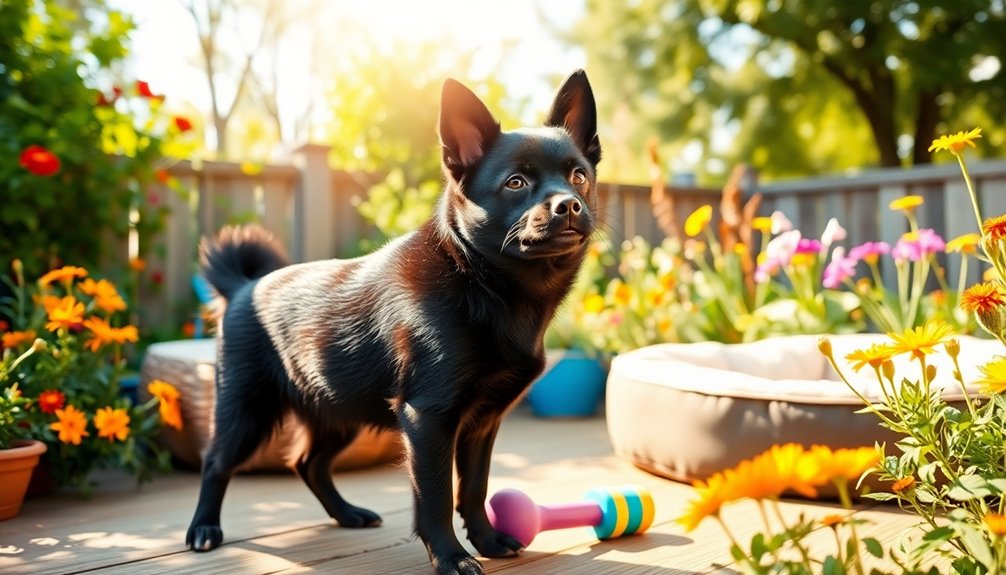
If you're considering a Schipperke, an urban apartment with a balcony can work well as long as you provide enough stimulation. These dogs thrive in temperate climates, making outdoor playtime essential for their energy levels. Just remember, regular exercise and safe spaces to roam are key to keeping them happy and healthy. Additionally, their high energy levels mean that daily activities should be varied to keep them engaged and prevent boredom.
Urban Apartment With Balcony
Living in an urban apartment with a balcony can be an ideal environment for a Schipperke. These small, cheerful dogs thrive in compact spaces, provided they get enough exercise and mental stimulation. Your Schipperke will enjoy exploring every nook and cranny of your apartment, keeping themselves entertained as they move from room to room. Schipperkes are known for their alert temperament, making them excellent watchdogs even in small living spaces.
Daily brisk walks and engaging play sessions are essential to keep them happy and healthy. While they can play games indoors, they also appreciate outdoor activities. Your balcony offers a perfect spot for fresh air and a little extra exercise, but always keep them leashed. Their curiosity might lead them to wander off in search of adventure.
Grooming your Schipperke is relatively low-maintenance compared to larger breeds, requiring only weekly brushing to manage shedding. Regular grooming helps keep their double coat in good condition.
With their energetic and inquisitive nature, Schipperkes make excellent companions in an urban setting, ready to protect your home and provide endless love and loyalty.
Embrace the playful spirit of your Schipperke, and you'll both enjoy a fulfilling life together in your apartment!
Temperate Climates Preferred
For a Schipperke, temperate climates offer the most comfortable living environment.
These little captains struggle in hot weather and can't tolerate extreme cold, so having air conditioning during summer is crucial. A cozy sweater is needed for chilly walks, as their double coat provides some insulation but not enough for severe temperatures.
Schipperkes thrive in spaces that allow them to move freely and explore.
A securely fenced yard is essential for safe playtime, and daily walks along with interactive games keep them happy and healthy. While they can adapt to urban or rural settings, it's vital to meet their exercise needs.
Common health concerns include hip dysplasia and patellar luxation, which can be exacerbated by extreme temperatures.
Avoid extreme weather conditions; regular shelter from harsh temperatures is a must.
A home with a yard provides the physical and mental stimulation they crave, and proper grooming is necessary to maintain their coat in varying climates.
Frequent play and training are essential to keep them engaged and prevent boredom-related behavior issues.
Early socialization helps them behave well around strangers and other animals.
With your care and attention, a Schipperke can thrive in a temperate climate, making their curious and energetic nature shine.
Vocal Alertness and Communication
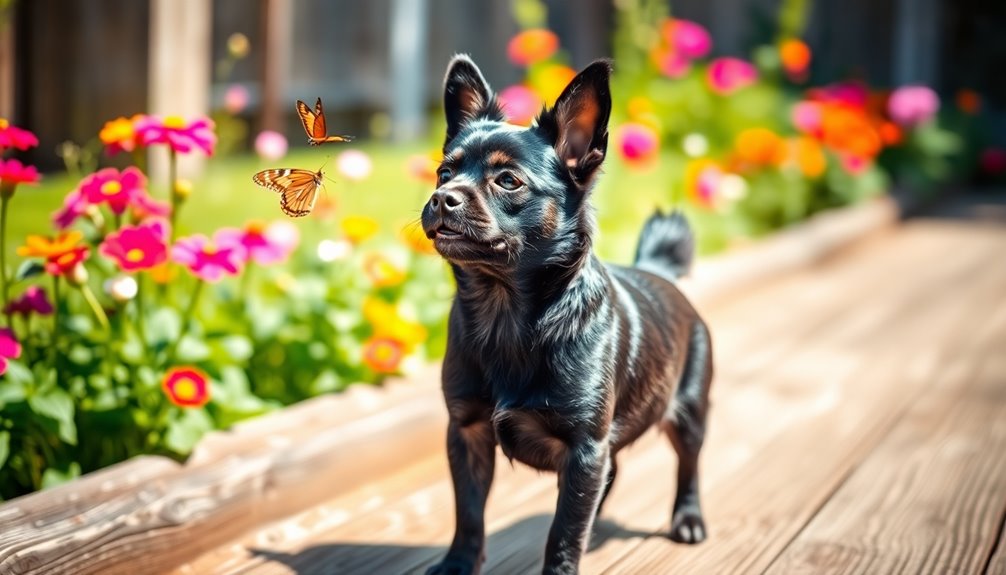
When you think of Schipperkes, their vocal nature often comes to mind, as they're known for barking at any perceived threat.
These little captains not only serve as excellent watchdogs, but their presence is also woven into Belgian folklore, highlighting their strong instincts. Their alert nature makes them particularly adept at announcing the presence of intruders, which is a key characteristic of the breed.
Understanding their vocal alertness can help you appreciate their protective spirit and communication style.
Vocal Watchdogs With Strong Instincts
Schipperkes are vocal watchdogs, renowned for their keen instincts and alert nature. Their deep and high-pitched barks make it clear that they're always on guard, ready to alert you to any potential danger. This breed's natural alertness means they're often suspicious of strangers, using their vocalizations to express their wariness.
It's crucial to socialize them early to manage their barking tendencies and ensure they only alert you when necessary. Their communication style is diverse, incorporating various barks and vocalizations to express curiosity and alertness.
Schipperkes engage with their families through body language and vocal cues, showcasing their intelligence and eagerness to explore their surroundings. Consistent training is vital; it helps channel their high energy and reduces excessive barking. Their adaptability allows them to thrive in various living environments, making them suitable for apartment living with the right exercise.
With strong guarding instincts rooted in their history, Schipperkes are fearless despite their small size. Their loyalty and vigilance make them protective companions, always ready to sound the alarm if needed.
Famous Schipperke in Belgian Folklore
How did the Schipperke earn its reputation in Belgian folklore? This spirited breed became a symbol of loyalty and protection, often featured in historical accounts.
In the 15th century, monk Wenceslas chronicled the Schipperke's role as a watchdog, particularly on the barges navigating Belgium's canals. Notably, William of Orange's life was reportedly saved by two tail-less jet black dogs, further solidifying the Schipperke's legendary status.
These dogs were integral to tradesmen guilds, particularly shoemakers, who valued their fierce loyalty. The custom of cutting tails even emerged from a story about quarreling shoemakers. The practice of tail-cutting began in 1609, showcasing the breed's unique appearance and history.
By the 1690s, Schipperkes were prominently exhibited in Brussels, showcasing their cultural significance. Celebrated for their vocal alertness, Schipperkes protected shops and farms from pests, earning the nickname "little black devil" for their fearless demeanor.
They wore elaborate brass collars, reflecting their esteemed status among the nobility, including Queen Marie Henriette of Belgium.
Today, the Schipperke remains a cherished part of Belgian canine heritage, embodying the spirit of the Little Captain while continuing to captivate dog lovers around the world.
Active Lifestyle Compatibility
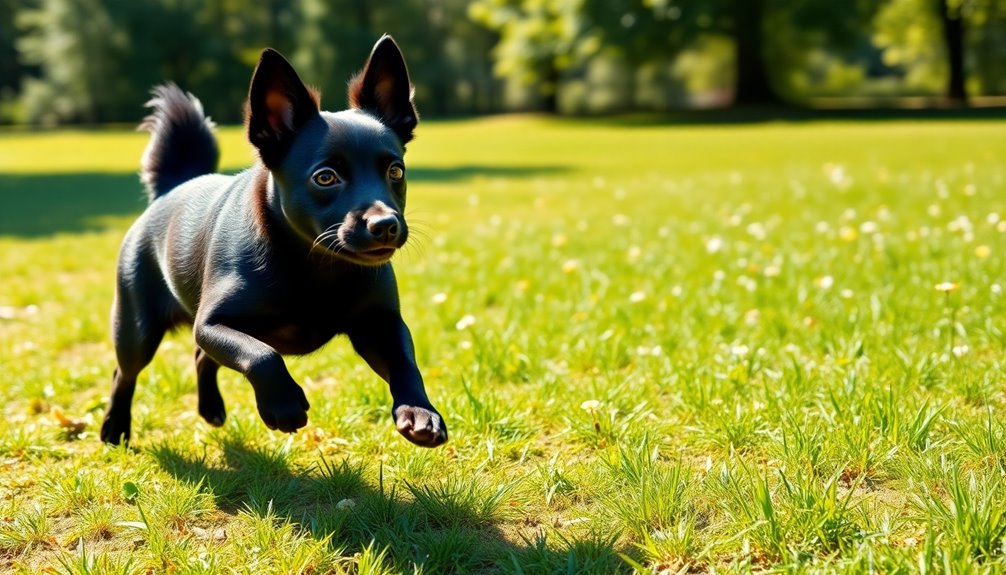
If you lead an active lifestyle, a Schipperke could be the perfect companion for you.
These energetic little captains require daily exercise and mental stimulation, making them ideal for those who enjoy brisk walks, play sessions, or even agility courses. Their high energy levels mean you'll find that they thrive on engaging activities alongside you. Regular outings for puppy socialization can further enhance their adaptability and confidence in various environments.
Energetic Companions for Active Owners
Looking for an energetic companion that matches your active lifestyle? The Schipperke is a perfect fit! With daily exercise needs of at least an hour, you can break this time into short, engaging bursts. Brisk walks and spirited play sessions are essential, so get ready for fetch, agility courses, and puzzle toys that keep both of you active and entertained. Schipperkes are known for their active, agile nature, which makes them even more enthusiastic about exercise.
Schipperkes love to play and can even entertain themselves during long walks. Indoor play in a fenced yard or dog park meets their exercise requirements while ensuring they stay safe.
Obedience training is vital, so start with basic commands like "sit," "stay," and "come." Keep training sessions short—about 10-15 minutes—to maintain their interest. Early socialization with kids, cats, and other dogs is also crucial for a well-rounded companion.
These little captains adapt well to various living conditions, whether you're in an apartment or a house. Just ensure you have a fenced backyard to keep them safe.
Schipperkes enjoy dog sports and mental stimulation activities, making them the ideal energetic companion for active owners like you!
High Energy and Stimulation Needs
The Schipperke's high energy levels and need for stimulation make them a perfect match for active lifestyles. You'll need to provide at least 30 to 40 minutes of exercise each day, which can include walks, jogs, or playful games of fetch in a fenced-in yard. These little captains can walk up to 10 miles or run five without tiring, so it's essential to keep their energy in check! Their intelligence means they thrive on mental challenges as well. Consistent, patient training is a must since they can be stubborn. Basic obedience commands like "sit," "stay," and "come" are essential, but they'll also appreciate advanced training and tricks to keep their minds engaged. Engaging in activities that promote executive function can enhance their ability to learn commands and solve problems. Socialization is crucial to curb excessive barking and ensure good behavior with people and other pets. Early socialization can help prevent the Schipperke's tendency towards dog aggression, making it even more important to expose them to various environments and experiences. Without enough stimulation, Schipperkes can become bored and exhibit destructive behaviors like chewing and digging. They need plenty of interaction with you to stay happy. While they can adapt to urban living without large yards, keeping them on a leash during outings and ensuring a safe, fenced-in area at home is vital for their well-being.
Frequently Asked Questions
Do Schipperkes Get Along With Other Pets?
Schipperkes can get along with other pets, but it largely depends on their training and socialization.
You'll need to introduce them to new animals early on to help avoid aggression. While they may coexist with other small dogs, be cautious around larger ones or small pets like hamsters and birds, as their high prey drive can lead to chasing.
Consistent training and supervision are key to fostering harmonious relationships among all your pets.
How Much Grooming Do Schipperkes Require?
Schipperkes require regular grooming to keep their coats in top shape.
You'll need to brush them weekly, and daily during shedding seasons to manage their undercoat.
Bathing can be every week to every four weeks, using a mild shampoo.
Don't forget to check their ears, trim their nails, and maintain dental hygiene regularly.
This routine helps prevent skin issues and keeps your Schipperke happy and healthy!
What Are Common Behavioral Issues in Schipperkes?
Common behavioral issues in Schipperkes often stem from a lack of activity and stimulation. You might notice excessive barking, chewing, or digging if they're bored.
They can also become anxious or aggressive without proper socialization. If left alone too long, destructive behaviors may arise.
To prevent these issues, ensure you provide plenty of exercise, engaging activities, and consistent training. Strong leadership and early socialization are crucial for a well-adjusted Schipperke.
Are Schipperkes Good for First-Time Dog Owners?
Schipperkes can be challenging for first-time dog owners due to their stubbornness and high energy levels.
You'll need to commit to early obedience training and socialization to curb any unwanted behaviors. They require plenty of exercise and mental stimulation, which can be demanding.
If you're an active person willing to invest time in training and socializing, a Schipperke could be a rewarding companion, but be prepared for their strong personality and needs.
How Can I Keep My Schipperke Mentally Stimulated?
To keep your Schipperke mentally stimulated, engage in activities like agility training and fetch, which combine fun and exercise.
Incorporate puzzle toys and scent work to challenge their mind. Regular obedience training with positive reinforcement helps maintain their interest.
Mix up daily routines with varied activities, ensuring they're active and engaged.
Don't forget to supervise playtime to prevent destructive behaviors while ensuring they've a high-quality diet for overall well-being.
Conclusion
In conclusion, the Schipperke is a lively and curious companion that thrives on activity and engagement. With their unique history and charming personalities, these little captains can bring joy and energy to your home. By providing proper training, socialization, and a stimulating environment, you'll create a fulfilling life for both you and your Schipperke. If you're ready for an adventurous and loyal friend, this breed might just be the perfect match for you!

